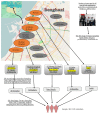Prevalence of Overweight and Obesity among Libyan Men and Women
- PMID: 31392214
- PMCID: PMC6662481
- DOI: 10.1155/2019/8531360
Prevalence of Overweight and Obesity among Libyan Men and Women
Abstract
Libya is following the trend observed in developing countries of steadily becoming more obese, such that obesity in Libya has reached epidemic proportions in the twenty-first century. The prevalence of obesity in Libya has more than doubled in the last three decades, with the numbers of overweight and obese adults being continuing to grow. Therefore, this study aimed to estimate and describe the prevalence of overweight and obesity among Libyan men and women. A cross-sectional survey was conducted to examine the prevalence of overweight and obesity among the Libyan population. A multistage sampling technique was employed to select 401 Libyan adults randomly from the Benghazi electoral register. Qualified nurses were allocated to take anthropometric measurements (including visceral fat and Body Mass Index (BMI)) from participants using the Segmental Body Composition Analyser and a portable Stadiometer. The response rate achieved in this cross-sectional study was 78%. Four hundred and one Libyan adult, aged 20-65 years, participated; 253 were female (63%). The prevalence of obesity, overweight, and normal weight among Libyan adults was 42.4%, 32.9%, and 24.7%, respectively. The results also revealed that approximately 75.3% of Libyan adults were overweight and obese, and the prevalence of overweight and obesity in women was significantly higher than that in men (the prevalence of overweight was 33.2% in women compared to 32.4% in men, while the prevalence of obesity was 47.4% in women compared to 33.8% in men, respectively). The findings of this study confirmed that obesity and overweight are the fastest growing issues and have become one of the most serious public health challenges confronting the Libyan authorities. As the obesity epidemic in Libya continues to escalate, with a complete absence of prevention interventions to reduce obesity, more research is desperately needed to follow the trend of gender difference in the prevalence of overweight and obesity among Libyans adults across the Libyan state to improve the effective interventions for preventing obesity.
Conflict of interest statement
The authors declare they have no conflicts of interest.
Figures









References
-
- World health organisation (WHO) Obesity and Overweight. 2018. (Fact Sheet no. 311). https://www.who.int/news-room/fact-sheets/detail/obesity-and-overweight/
-
- Medvedyuk S., Ali A., Raphael D. Ideology, obesity and the social determinants of health: a critical analysis of the obesity and health relationship. Critical Public Health. 2017;28(5):573–585. doi: 10.1080/09581596.2017.1356910. - DOI
Publication types
MeSH terms
LinkOut - more resources
Full Text Sources
Medical
Research Materials

